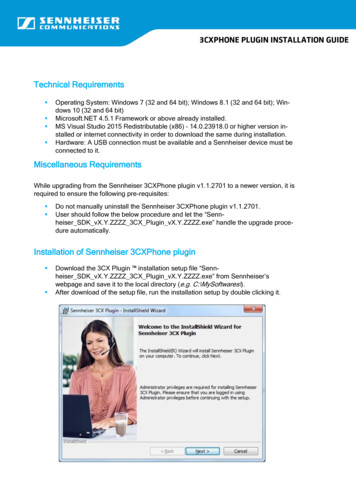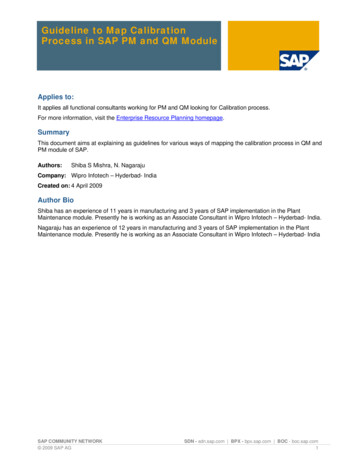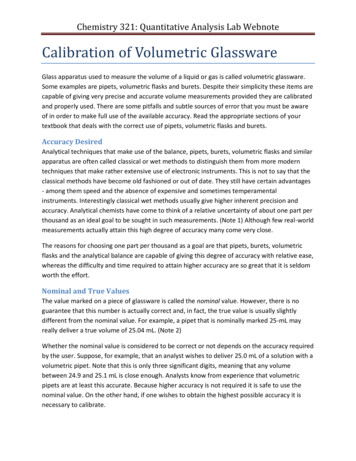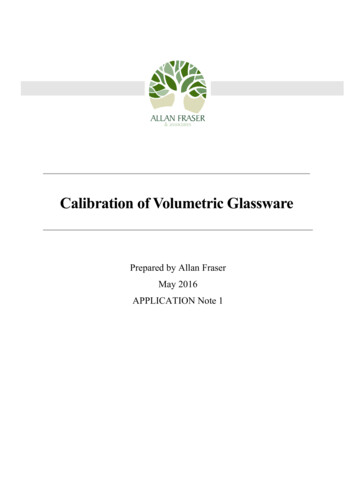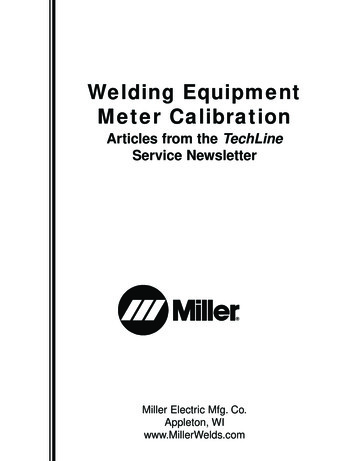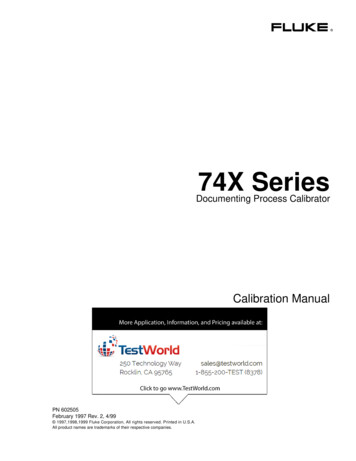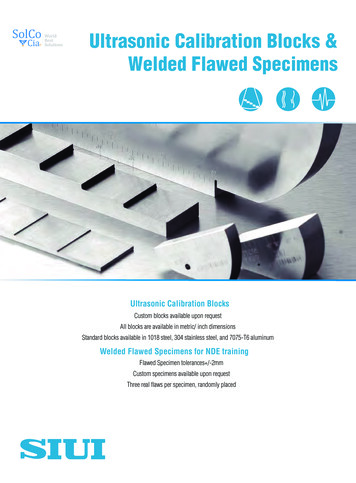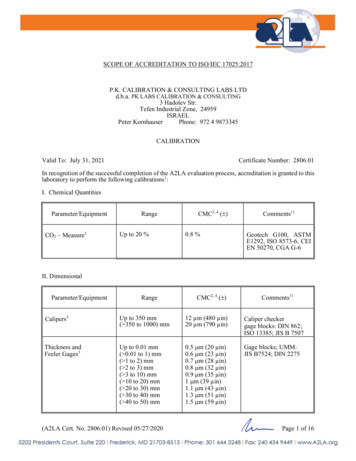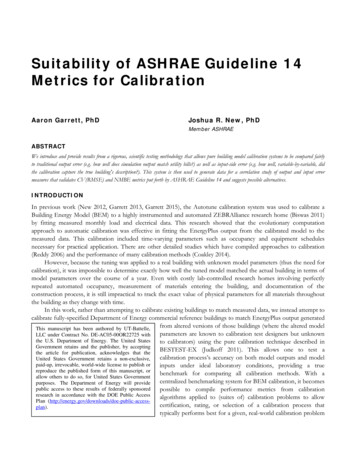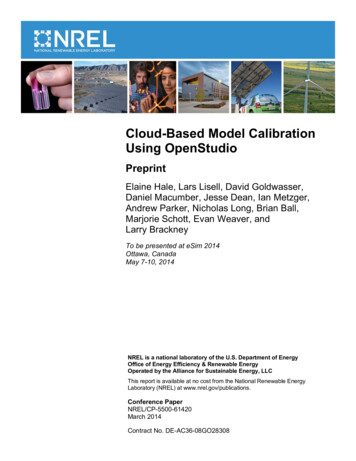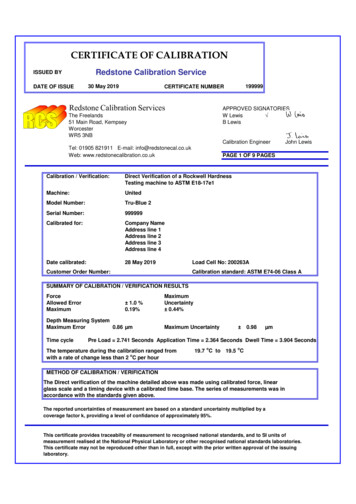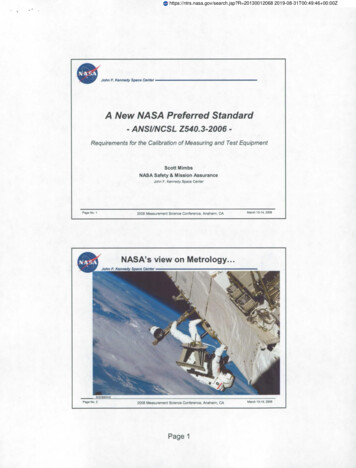
Transcription
https://ntrs.nasa.gov/search.jsp?R 20130012068 2019-08-31T00:49:46 00:00Za' John F.Kennedy Sp.c. C.ntetA New NASA Preferred Standard— ANSIINCSL Z540.3-2006 Requirements for the Calibration of Measuring and Test EquipmentScott MimhisNASA Safety & Mission AssuranceJohn F Kennedy Space CenterPage NO 1March2008 Measurement Science Conference, Anaheim. CA13- 14. 2008NASA's view on Metrology.J hn FKnedy Space Centereefo Page No 22008 Measurement Science Conference,Page 1Anatierrn,CA---
Outgoing and Incoming StandardsJohn F. Kennedy Space CenterNASA policy requires the use of "domestic and internationalvoluntary consensus standards," in lieu of creating Governmentstandards.The exception is when "they would demonstrably fail to serveNASA's program needs." ANSIINCSL Z540.1 (R2002), Calibration Laboratories andMeasuring and Test Equipment - General Requirements.1. Adopted by NASA in 19952. Currently NASA requirement per NPD 8730.1BANSI/NCSL Z540.3:2006, Requirements for the Calibration ofMeasuring and Test Equipment.1. Reviewed by NASA Metrology and Calibration Working Groupbeginning September 20062. Recommended as a NASA Preferred Standard August 2007Page No 32008 Measurement Science Conference, Anaheim, CAMarch 13-14, 2(5)8Differences in ScopeJohn F. Kennedy Space CenterANSI/NCSL Z540.1 (R2002)Part I - establishes the competency requirements of a calibration provider.- Based on ISO Guide 25 (cancelled)- Some elements similar to ANS/ISO/IEC 17025Part II - establishes the quality assurance requirements for a supplier ofcalibration services.- Based on MIL-STD-45662- Some elements similar to ISO 10012ANSI/NCSL Z540.3:2006Establishes the requirements for a calibration system to control theaccuracy of measuring and test equipment.- Address optional use of ANS/ISO/lEc 17025- Some elements similar to ISO 10012Page No 42008 Measurement Science Conference, Anaheim, CAPage 2March 13-14, 2008
Significant Differences in Z540.3John F. Kennedy Spec. CenterANS/lSO/IEC 17025 and ISO 10012 address calibrationand measurement systems. Their shortcomings wereconsidered in the creation of Z540.3 to either address inbetter detail or by providing additional requirements inthe following areas: calibration intervals & measurement reliability; Calibration & measurement assurance procedures; Tolerance-type calibrations; Measurement risk and test uncertainty ratio (TUR) use; Measurement uncertainty procedure; Non-laboratory type calibration services.Page No 52008 Measurement Science Conference,Anaheim, CAMarch 13-14.2008Z540.3 Highlights — General RequirementsJohn F. Kennedy Space CenterZ540.3:Levies requirements to the overall organization wherethe Calibration Lab may only be a component.4.1 Calibration system objective The orshall establish, document, operate, and improve psyste r-- to manage the calibration of measuring and test equipment.4.2 Quality objectives The organzaton shall define and establish measurable qualityobjectives for the calibrator system and its components.Page NO 62008Measurement Science Conference, Anaheim, CAPage 3March 13-14,2008
Z540.3 Highlights— Calibration System implementationJohn F. Kennedy Space Center5.1 Calibration requirements The org anization shall include all measuring and testequipment in the calibration system that have an influence onthe quality of the organization's product. The organization shall document and use procedures for thedetermination of measuring and test equipment to be includedin the calibration system. [ . ]5.2.3.1 As-found calibration Establishes a requirement for the closed-loop reporting ofequipment found out-of-tolerance during calibration.The organization must set the criteria of how much out-oftolerance can be tolerated before action is required.Page No '2008 Measurement Science Conference, Anaheim, CAMarch 13-14, 2008Z540.3 Highlights— Calibration System implementationJohn F. Kennedy Space Center5.3 Calibration of measuring and test equipmentSpecifies that calibrations may be performed outside a laboratoryin situ,on-site, customers facility,Provides that levels of measurement decision risk be acceptable toboth the customer and supplier. Measurement uncertainty is to be used where calibrations only reportmeasured values (e.g., Standard Labs), Verification of specified tolerances will use a risk metric: the probability ofincorrect acceptance decisions (false accept) shall not exceed 2% Test uncertainty ratios (TUR) of 4:1 or better are allowed when determiningthe risk probability is not practicable.In conjunction with this sub-clause, demonstration of calibrationcompetency is deferred to ANS/Iso/lEc 17025, or "otherwise found to be in conformance by an authority acceptable to thecustomer."Page NO 82008Measurement Science Conference, Anaheim, CAPage 4March 13-14, 2008
Z540.3 Highlights— Calibration System implementationJohn F. KennedySpa ce C.msr5.3.3.1 Expression of measurement uncertaintymented procedure shall be used to estimate and express theAuncertainty of measurement for all calibrations. As a minimum, theprocedure shall address:a) sources of measurement uncertainty;b) estimation and combining of uncertainties;c) conditions and assumptions;d) documentation and reporting criteria; ande) bibliography.NOTE 1: Sources of measurement uncertainty that should be addressedinclude:- measuring and test equipment associated with the calibration;- measurement and calibration methods and procedures;- measurement traceability:- measurement repeatability and reproducibility;- calibration quality monitoring;- changes over time; and- influence quantities.NOTE 2: For quidance on the expression of measurement uncertainty, seeANSINCSL Z540-2-1 997 (R2002)'age No 92008 Measurement Science Conference, Anaheim. CAMarch 13-14,2008NASA's Issues & ConcernsJohn F. Kennedy Space Center1.The most significant issues and concerns within NASA, centers on the2% rule of Section 5.3. Currently no industry or government standards for estimating measurement riskbased on the Z540.3 definition NCSLs Recommended Practice for risk is still in draft2.The Z540.3 Handbook being developed by NCSLI is not 'Interpretive"by definition;3.Therefore NASA must identify and make the interpretation for thosesections of the Standard that could potentially have the most impacts toNASA operations. Establish when 2% false accept risk 'good enough." Provide acceptable measurement decision risk analysis techniques. Define 'practicable." What level of effort/expense is required? Establish guidance for when the using the 4:1 TUR is appropriate. Define the appropriate calibration competence authorityANS/ISO/IEC 17025: Accreditation versus CompliancePage No ID2008 Measurement Science Conference. Anaheim, CAPage 5March 13.14, 28
Resolving the Issues & ConcernsJohn F. Kennedy Space Center1. NASA is updating its metrology policy to add Z540.3 forcalibration programs.2. NASA is developing an interim guidance document forimplementing the 2% rule of Section 5.3. Use current "Body of knowledge' - do not create new material' Current version of RP 1342V'Industry papers Focus on implementation Provide guidance if requirement can not be met To be released in early summer 20083. NASA is drafting a procedural requirements document toprovide acceptable boundaries for implementing Z540.3.Page No 112008 Measurement Science Conference, Anaheim, CAMarch 13-14. 2008SummaryJohn F. Kennedy Space Center1. Z540.3 addresses the requirements and responsibilitiesof the Calibration System.2. The overall organization is responsible for the M&TEcalibration program (e.g., NASA, Program, Contractor,etc.).3. Calibration providers have defined quality requirements.4. Demonstration of calibration competency is deferred toANS/ISO/IEC 17025.5. NASA is addressing internal concerns for Z540.3implementation.Page N. 122008 Measurement Science Conference, Anaheim, CAPage 6March 13-14,2008
Page 7
A .,,.And more difficult.John F Kennedy Space Center1 ithPage No 152008 Measurement Science Conference, Anaheim, CAPage 8AAW-March 13-14, 2008
ANSI/NCSL Z540.3:2006, Requirements for the Calibration of Measuring and Test Equipment. 1. Reviewed by NASA Metrology and Calibration Working Group beginning September 2006 2. Recommended as a NASA Preferred Standard August 2007 Page No 3 2008 Measurement Science Conference, Anaheim, CA March 13-14, 2(5)8 Differences in Scope
